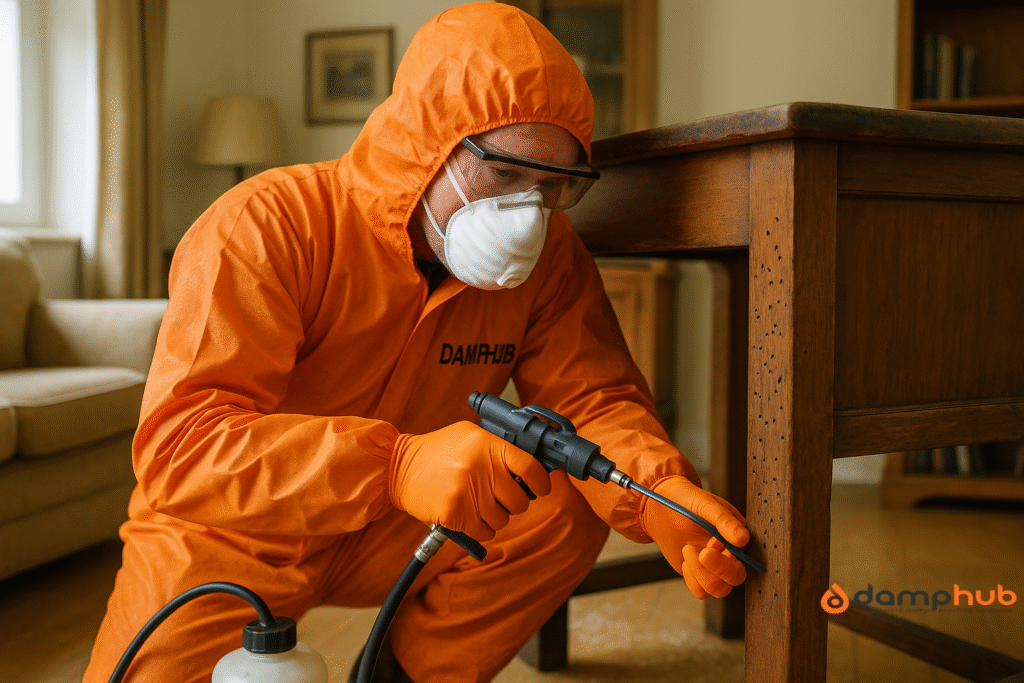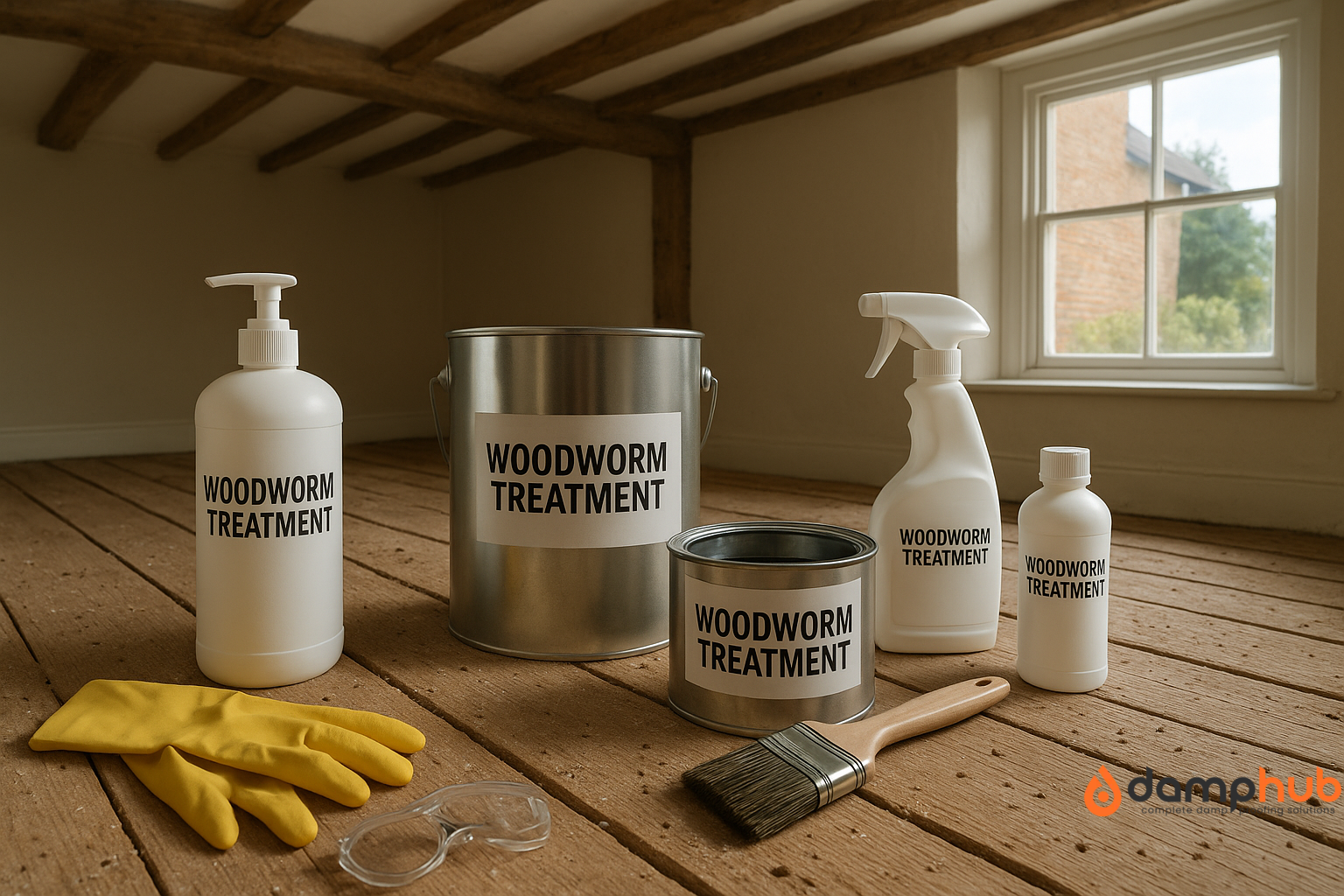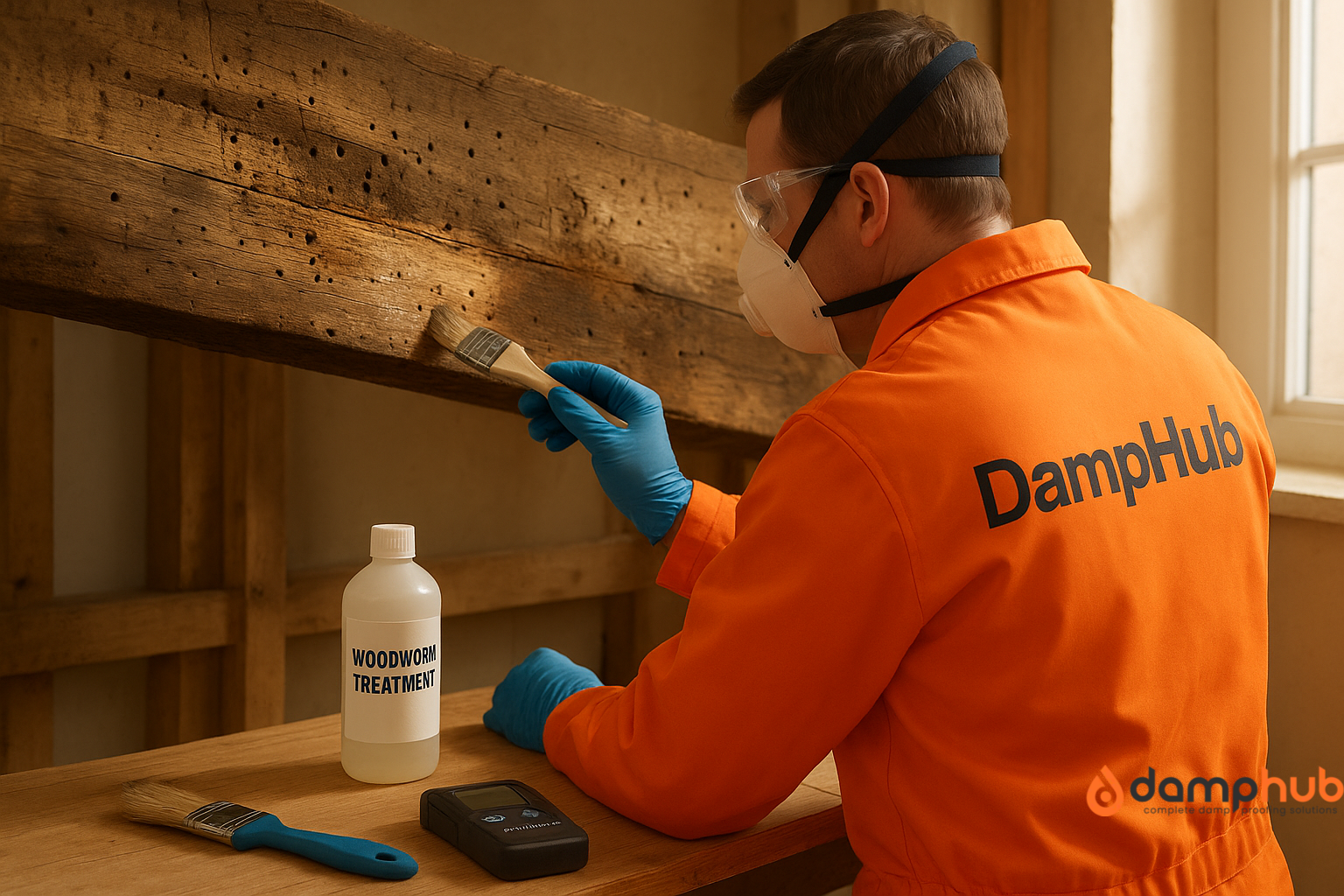
You might be asking “what is woodworm in furniture”, but if you’ve spotted unusual marks on furniture, for example, a scattering of pale dust beneath a chair leg, or rows of pin-sized holes peppering an old oak drawer, it’s often a quiet sign of woodworm active inside the wood.
In the UK, “woodworm” is the catch-all name for the larvae of several wood-boring beetles. They’re not worms at all. They’re tiny grubs that live, feed, and grow within the timber, sometimes for years, before chewing their way out as adults.
They favour certain timbers like pine, beech, and oak, but aren’t picky if the conditions are just right. A touch of damp. Stale air. Wood that’s been sitting in a loft, a shed, or pressed against a cold wall. Once inside, the larvae carve narrow tunnels through the grain, weakening it from within. By the time you see holes, there is damage to repair.
It’s not just about losing a single piece of furniture. Left alone, they can spread to other items nearby, including floorboards and skirting, and those “small holes” become part of a much bigger repair bill.
What Causes Woodworm in Furniture
It starts with eggs. A female beetle lays them on bare timber, in cracks, or deep in joints where the surface is rough enough for them to stick. Some species prefer softwood, while others lean towards hardwood, but all are drawn to one thing: moisture.
Timber with a moisture content above roughly 15–20% is far more attractive. That’s why poorly ventilated rooms, leaking pipes, or furniture stored against damp exterior walls are such a common starting point.
In the UK, the Common Furniture Beetle is the usual suspect, but others like the Deathwatch Beetle can turn up in older oak pieces, especially those from period homes.
Once the eggs hatch, the larvae bore straight into the wood and vanish from sight. They’ll stay there for two to five years, chewing slowly through the fibres until they’re ready to leave.
Signs of Woodworm in Furniture
Most of the damage from woodworm in furniture is hidden, so the clues are small and easy to miss. Signs to look for include:
- Small, round exit holes — usually 1–2mm wide.
- Crumbling edges or corners — often on undersides or near joints.
- Light, weakened feel — the piece might seem strangely light for its size.
- Adult beetles nearby — small, brown, and active in warmer months, often found near windows.
- Frass — a fine, pale powder beneath or inside holes, made up of chewed wood.

Pro Tip
Clear away any dust under suspect furniture, then check again in a week. If it’s back, something is still feeding inside.
How to Get Rid of Woodworm in Furniture Naturally
Sometimes chemical treatments feel like overkill — especially for smaller items or pieces with sentimental value.
There are gentler approaches, but they take patience. Some of the best natural methods of treating woodworm in furniture include:
1. Reduce Moisture to Stop Woodworm
Woodworm larvae rely on moisture inside the timber to survive. Keep the furniture in a warm, dry room with humidity under 50% for several weeks. A heated spare room in summer — with the windows shut — works well.
2. Freeze Woodworm Out of Small Items
Wrap smaller furniture pieces tightly in heavy plastic and place them in a commercial freezer for at least two weeks. This kills larvae at every stage. Be careful with delicate veneers or joints; sudden temperature changes can cause cracks.
3. Apply Natural Oils to Woodworm Holes
Neem oil, orange oil, and clove oil can be brushed directly into exit holes. These may deter emerging beetles, though they’re less reliable than controlling temperature or humidity.
4. Isolate the Furniture in Airtight Wrapping
Seal the item inside an airtight plastic wrap or bag. This cuts off oxygen and can weaken larvae, especially if you also add a drying agent like silica gel or use a heated environment.
5. Use Direct Sunlight to Kill Woodworm
On dry days, place the furniture in direct sunlight for several hours, rotating it so all sides heat evenly. This can help drive out larvae, but be careful, as too much heat can warp delicate wood.
For a full breakdown on how to get rid of woodworm, check our detailed guide: DIY Woodworm Treatment: Natural and Chemical Solutions That Actually Work
How to Fill Woodworm Holes in Furniture
After you’ve treated your furniture for woodworm, those little holes left behind can be an eyesore—and if left unfilled, they might leave the wood vulnerable to further damage. Don’t worry, filling them is straightforward.
Follow these steps based on your furniture type:

Step 1: Assess Your Furniture Finish
- Is it painted, stained, polished, or antique? This will affect your choice of filler.
Step 2: For Painted Furniture
- Choose a wood filler or putty that closely matches the paint colour.
- Using a small spatula, press the filler firmly into each hole, making sure deep channels are filled completely.
- Allow it to dry fully.
- Sand the surface smooth so it blends seamlessly with the surrounding wood.
Step 3: For Stained or Polished Furniture
- Select wax filler sticks that match the wood tone.
- Warm the stick slightly between your fingers to soften it for easier application.
- Press the wax into the holes, shaping it to fit irregular holes.
- Buff gently to blend the filler with the wood grain.
Step 4: For Antique Furniture
- Decide if you want to keep the small holes as part of the piece’s character.
- If yes, treat and seal the wood to stop further damage, but skip filling the holes cosmetically.
- This approach respects the furniture’s history and value.
Pro Tip
Avoid overfilling holes to prevent lumps that catch light. Aim for a smooth, level finish.
How Long Does Woodworm Live in Furniture?
The answer depends on the species. The common furniture beetle — by far the most frequent culprit in UK homes — spends most of its life hidden inside the wood as a larva. That stage alone can last anywhere from two to five years.
Adult beetles live for just a few weeks, long enough to mate and lay eggs before dying. The trouble is that during those years inside, larvae quietly eat through the timber’s fibres. By the time you spot holes, the insects may have been residents for years.
This slow life cycle is why infestations can seem to “suddenly” appear — the activity was there all along, just out of sight.
Good to Know
If you treat a piece today, new beetles may still emerge for a year or two afterwards. These aren’t signs the treatment failed — they’re simply larvae that were near the surface when you applied it.
How Much Does Woodworm in Furniture Cost to Remove in the UK?
The cost of removing woodworm from furniture in the UK varies based on the extent of the infestation, the type of treatment required, and the service provider.
Here’s a breakdown to help you understand potential expenses:
Average Costs for Woodworm Treatment
- Professional Treatment: Typically ranges between £500 and £1,000, depending on the severity and location of the infestation.
- DIY Treatment: For minor infestations, DIY solutions using woodworm treatment sprays can cost between £35 and £100.
Additional Considerations
- Survey Costs: Before treatment, a professional survey is recommended to assess the extent of the infestation. These surveys typically cost between £80 and £250.
- Treatment Methods:
- Spraying: Common for treating furniture; involves applying a woodworm treatment solution directly to the affected areas.
- Fogging: Used for larger areas, such as lofts or rooms with extensive infestations.
- Fumigation: A more intensive method, often reserved for severe cases.
- Location Factors: Costs can vary by region, with areas like London and the South East often seeing higher prices due to increased demand and living costs.

If you are considering a woodworm treatment, we have broken down the factors that affect costs in our other guide: Woodworm Treatment Costs Explained: Prices, Factors and How to Save
Which is the Best Woodworm Killer for Furniture?
Choosing the right woodworm treatment depends mainly on two things: the kind of infestation and the type of furniture finish.
Picking the wrong product can damage delicate antiques or leave the problem unresolved. Here’s a quick guide to help decide what works best for your furniture.
- Avoid general bug sprays or DIY remedies that don’t penetrate wood properly: They usually fail to reach the larvae deep inside, leaving the infestation to continue.
- Boron-based treatments are the go-to for most modern UK homes: These soak deep into the wood and tackle both the larvae lurking inside and the adult beetles.
- For antiques or delicate finishes, water-based treatments are safer: They’re gentle on original varnishes and patinas, reducing the risk of surface damage.
- Always check the product label closely: Make sure it’s designed specifically to kill wood-boring insects, not just a general insecticide.
- Application is just as important as the product itself: Remove drawers, panels, and any detachable sections to treat every nook and cranny.
- Cover all surfaces: These include the front, back, underside, and joints—because woodworm can hide anywhere.
Good to Know
Even after treatment, keep the furniture in a dry, airy space. Damp corners and poor airflow make the perfect nursery for the next wave of beetles.
How to Prevent Future Return of Woodworm in Furniture
Stopping woodworm from coming back is all about making your furniture and home less inviting for those pesky beetles.
Here’s how you can keep them at bay:
- Keep Wood Dry: Woodworm thrives in damp, poorly ventilated conditions. Make sure your furniture stays dry by controlling humidity and fixing any leaks or damp spots nearby.
- Improve Ventilation: Good airflow helps prevent the moisture buildup that woodworms love. Open windows regularly and consider using dehumidifiers in damp rooms.
- Use Treated Wood or Sealants: When buying new furniture, opt for wood that’s been treated against woodworm, or apply a wood preservative or varnish to create a protective barrier.
- Regular Inspections: Check your furniture often for early signs like small exit holes or fine wood dust (frass). Catching woodworm early means easier treatment.
- Avoid Bringing In Infested Wood: Be cautious when buying second-hand furniture or wood materials—inspect carefully or ask about their history.
- Professional Treatments: For vulnerable or valuable pieces, consider preventive treatments with woodworm-resistant chemicals recommended by professionals.
Following these steps can seriously lower the chances of woodworm making a comeback, keeping your furniture safe and sound.
Related article: What to Do when a Woodworm Survey Reveals Woodworm?
Woodworm in Furniture: Common Questions Answered

-
Should I get rid of furniture with woodworm?
Not always. If it’s just a few fresh holes here and there, you can usually treat it and keep the piece. The trick is to catch it early and make sure you’ve killed off the larvae — otherwise they’ll keep chewing from the inside out.
But if the damage runs deep — soft, crumbly patches, joints that are coming loose, or wood that’s practically hollow — then honestly, it’s probably not worth the hassle. You’ll end up spending more on repairs than it’s worth.
-
How fast can woodworm in furniture spread?
Think in terms of years, not days. They’re not sprinting through the timber overnight — but give them a few seasons and you’ll start seeing new flight holes appear across a bigger area.
The real danger is when you’ve got them in multiple pieces close together, or the room’s a bit damp. That’s when the beetles can emerge in summer, take a short flight, and lay eggs in nearby wood. Slowly but surely, the problem moves along the furniture line.
-
Does woodworm in furniture smell?
Freshly bored wood can give off a faint, dusty, almost musty scent — but it’s subtle. Most people won’t notice it unless the infestation’s heavy and the timber’s been kept somewhere with poor ventilation.
What you’re more likely to see (or sweep up) is frass — that fine, pale sawdust they leave behind. The smell itself isn’t a reliable sign. If you can smell the furniture from across the room, you’re probably dealing with damp rather than the beetles themselves.
-
What attracts woodworms?
They’ve got simple tastes — they like timber with a bit of moisture in it, and they’re not fussy about whether it’s oak, pine, or cheap ply. Old furniture that’s been stored in a loft, garage, or against an external wall is a favourite.
They go for softer patches of wood where it’s easier for the larvae to chew. And if the piece is already a little damaged, with cracks or rough edges, it’s practically an open invitation.
-
How Long Does it Take for Woodworm Holes to Appear in Furniture?
Woodworm holes usually start to show up several months after the beetle larvae have begun feeding inside the wood. Typically, you might notice tiny exit holes about 1 to 3 millimetres wide after 6 to 12 months.
However, this can vary depending on the type of woodworm, the wood’s moisture level, and environmental conditions. So, sometimes it might take longer before those tell-tale holes and wood dust (called frass) become visible.






